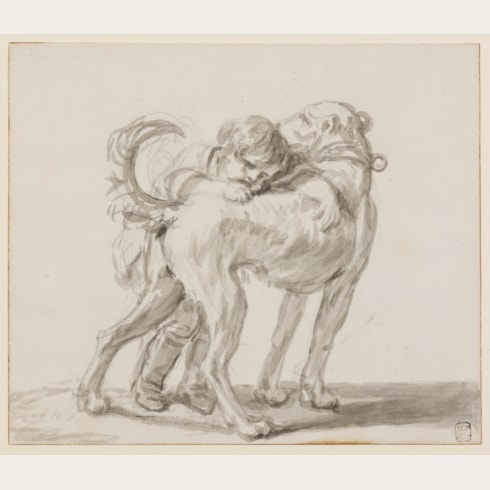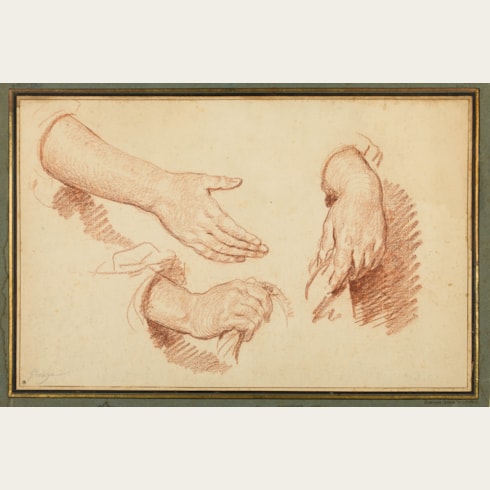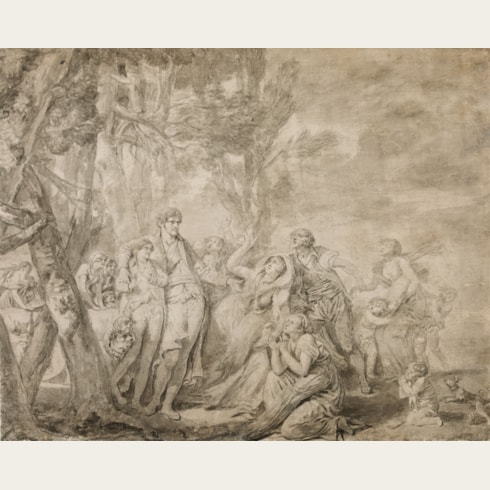Jean-Baptiste GREUZE
(Tournus 1725 - Paris 1805)
The Triumph of Silenus
Pen and brown and black ink and grey wash, over an underdrawing in black chalk, with framing lines in brown ink.
Laid down on an 18th century French mount.
Inscribed J. B. Greuze at the lower right.
Further inscribed Marche de Silene and J Bte Greuze on a former backing sheet.
538 x 378 mm. (21 1/8 x 14 7/8 in.)
Laid down on an 18th century French mount.
Inscribed J. B. Greuze at the lower right.
Further inscribed Marche de Silene and J Bte Greuze on a former backing sheet.
538 x 378 mm. (21 1/8 x 14 7/8 in.)
Previously known only through descriptions in 18th and 19th century French auction catalogues, this large and impressive sheet is a recently discovered and highly significant addition to the corpus of drawings by Jean-Baptiste Greuze. Given its large scale and degree of finish, it is very likely to have been made as a finished work of art for sale; indeed, it remains on its original mount. Furthermore, this Triumph of Silenus may be counted among the very few mythological subjects treated by Greuze as a draughtsman. As such, it may have been made sometime in the late 1760s, when the artist was contemplating what the subject of his morceau de reception for the Académie Royale should be. What may be a related composition by Greuze, a drawing also depicting the Bacchic figure of Silenus, appeared at auction in France in 1859.
Among stylistically comparable, finished pen and wash drawings by Greuze are The Departure of the Young Savoyard in the collection of the Amsterdam Museum, The Return from the Wet Nurse in the British Museum in London and A Savoyard with a Dancing Doll in the Albertina in Vienna.
The present sheet has a distinguished provenance that can be traced back to the artist’s lifetime. The first known owner of this drawing was the 18th century French art dealer Vincent Donjeux (d.1793), about whom relatively little is known, although the Almanach général des marchands, négocians et commerçans de le France et de l’Europe of 1772 notes that he was also a painter, and that his premises were located on the rue des Fossés-Montmartre in Paris. Donjeux’s collection included a small but interesting group of Italian, Netherlandish and French drawings. He is also known to have worked in collaboration with the wealthy financier and collector Laurent Grimod de La Reynière – who owned a number of significant works by Greuze - in organizing an auction of paintings in February 1773.
This Triumph of Silenus is next recorded in the collection of the amateur landscape painter, printmaker and draughtsman Baron Charles de Vèze (1788-1855), who exhibited at the Salons between 1837 and 1839. At Baron de Vèze’s posthumous sale in 1855 this drawing was acquired by the politician, scientist and writer François Hippolyte Walferdin (1795-1880). Walferdin formed a remarkable collection that was particularly notable for including some eighty paintings and over seven hundred drawings by Jean-Honoré Fragonard. Walferdin also owned at least fifty drawings by Greuze, most of which were dispersed in two auctions after his death in 1880. The present sheet, however, was one of fourteen drawings by Greuze sold by Walferdin at auction in Paris twenty years earlier.
Among stylistically comparable, finished pen and wash drawings by Greuze are The Departure of the Young Savoyard in the collection of the Amsterdam Museum, The Return from the Wet Nurse in the British Museum in London and A Savoyard with a Dancing Doll in the Albertina in Vienna.
The present sheet has a distinguished provenance that can be traced back to the artist’s lifetime. The first known owner of this drawing was the 18th century French art dealer Vincent Donjeux (d.1793), about whom relatively little is known, although the Almanach général des marchands, négocians et commerçans de le France et de l’Europe of 1772 notes that he was also a painter, and that his premises were located on the rue des Fossés-Montmartre in Paris. Donjeux’s collection included a small but interesting group of Italian, Netherlandish and French drawings. He is also known to have worked in collaboration with the wealthy financier and collector Laurent Grimod de La Reynière – who owned a number of significant works by Greuze - in organizing an auction of paintings in February 1773.
This Triumph of Silenus is next recorded in the collection of the amateur landscape painter, printmaker and draughtsman Baron Charles de Vèze (1788-1855), who exhibited at the Salons between 1837 and 1839. At Baron de Vèze’s posthumous sale in 1855 this drawing was acquired by the politician, scientist and writer François Hippolyte Walferdin (1795-1880). Walferdin formed a remarkable collection that was particularly notable for including some eighty paintings and over seven hundred drawings by Jean-Honoré Fragonard. Walferdin also owned at least fifty drawings by Greuze, most of which were dispersed in two auctions after his death in 1880. The present sheet, however, was one of fourteen drawings by Greuze sold by Walferdin at auction in Paris twenty years earlier.
Following a period of study in Lyon, Jean-Baptiste Greuze arrived in Paris sometime in the early 1750s and began studying drawing with Charles-Joseph Natoire and Louis de Sylvestre. Very little is known of the artist’s early Parisian period, however. He was admitted into the Académie Royale as an associate member in 1755, in the category of peintre de genre particulier, and the same year exhibited several works at the Salon with some success, with three of the paintings acquired by the influential collector Ange Laurent de La Live de Jully. (Greuze did not, however, supply a morceau de recéption to the Académie, which was required in order to gain full membership as an Academician, until 1769.) In September 1755 the young artist travelled to Italy with another influential patron, the Abbé Gougenot, and he worked in Rome, mainly on portrait commissions and genre paintings, until the spring of 1757. Greuze’s paintings of moralizing genre subjects, exhibited at the biennial Salons from 1761, earned him the praise of the influential critic Denis Diderot. He was also a fine portraitist, exhibiting a number of portraits at the Salon throughout the 1760s to considerable acclaim.
While Greuze enjoyed the patronage of such prominent collectors as La Live de Jully, Madame de Pompadour and her brother, the Marquis de Marigny, Jean de Jullienne, the Duc de Choiseul and the Empress Catherine II of Russia, his difficult temperament often alienated other clients. (Indeed, even the artist’s great champion Diderot, writing to the sculptor Etienne Falconet in 1767, described Greuze as ‘an excellent artist but a bad-tempered fellow. One should collect his drawings and his pictures and otherwise leave him alone.’) Notwithstanding his success as a painter of genre subjects and portraits, Greuze always aspired to be recognized as a history painter. Throughout the 1760s he had considered various themes for his long-overdue morceau de reception for the Académie Royale, which he wanted to be of a mythological, Biblical or historical subject. In 1769, some fourteen years after he was agrée at the Académie, he finally submitted a painting of Septimus Severus Reproaching Caracalla as his reception piece. However, the work was rejected by the Académie, who instead admitted the artist only as a genre painter. Angered and humiliated by this snub, Greuze henceforth refused to exhibit at the Salons, choosing instead to show his paintings in his studio in the Louvre, where they attracted a good deal of public interest. He continued to enjoy considerable success throughout the 1770s and 1780s, especially among Russian patrons, and also profited from the sale of prints after his works. His reputation began to suffer in the years after the Revolution and with the rise of Neoclassicism, although by 1800 he had returned to exhibiting his works at the Salon, after an absence of thirty-one years, and continued to do so until 1804, when among the works he showed was a fine self-portrait. Greuze died, in his studio, at the age of nearly eighty, and was buried in the cemetery of Montmartre.
Greuze was a gifted and versatile draughtsman, equally adept in chalk, pastel and ink. From 1757 onwards he regularly showed finished drawings as well as oil paintings at the Salons, and one critic, writing of the 1761 exhibition, noted ‘Several drawings by M. Greuze...do him as much honour by their execution as by the choice and genius of their invention.’ The artist’s drawings were also often praised by Diderot, who noted that ‘this man draws like an angel…He is enthusiastic about his art: he makes endless studies; he spares neither care nor expenses in order to have the models that suit him.’ Greuze produced many preparatory studies, including compositional studies in pen and ink and head, hand and figure studies in chalk, for each of his painted compositions. A particular interest was the study of physiognomy and facial expression, made manifest through large-scale drawings of têtes d’expression. These drawings of heads, usually in red chalk, allowed the artist to refine the facial types and expressions that were such an important part of his paintings, but they were also produced as independent works of art, to be sold to collectors. Indeed, Greuze enjoyed a healthy market for his finished drawings; as the 18th century collector and connoisseur Pierre-Jean Mariette noted of him, ‘Il a fait aussi nombre de desseins, qui, dans le commencement, lui ont été payés prodigieusement par quelque curieux.’ Greuze’s drawings found their way into important 18th century collections in France, Russia and Germany, while several fellow artists, including Aignan-Thomas Desfriches, Claude Hoin, Joseph-Marie Vien and Johann Georg Wille, owned drawings by him.
While Greuze enjoyed the patronage of such prominent collectors as La Live de Jully, Madame de Pompadour and her brother, the Marquis de Marigny, Jean de Jullienne, the Duc de Choiseul and the Empress Catherine II of Russia, his difficult temperament often alienated other clients. (Indeed, even the artist’s great champion Diderot, writing to the sculptor Etienne Falconet in 1767, described Greuze as ‘an excellent artist but a bad-tempered fellow. One should collect his drawings and his pictures and otherwise leave him alone.’) Notwithstanding his success as a painter of genre subjects and portraits, Greuze always aspired to be recognized as a history painter. Throughout the 1760s he had considered various themes for his long-overdue morceau de reception for the Académie Royale, which he wanted to be of a mythological, Biblical or historical subject. In 1769, some fourteen years after he was agrée at the Académie, he finally submitted a painting of Septimus Severus Reproaching Caracalla as his reception piece. However, the work was rejected by the Académie, who instead admitted the artist only as a genre painter. Angered and humiliated by this snub, Greuze henceforth refused to exhibit at the Salons, choosing instead to show his paintings in his studio in the Louvre, where they attracted a good deal of public interest. He continued to enjoy considerable success throughout the 1770s and 1780s, especially among Russian patrons, and also profited from the sale of prints after his works. His reputation began to suffer in the years after the Revolution and with the rise of Neoclassicism, although by 1800 he had returned to exhibiting his works at the Salon, after an absence of thirty-one years, and continued to do so until 1804, when among the works he showed was a fine self-portrait. Greuze died, in his studio, at the age of nearly eighty, and was buried in the cemetery of Montmartre.
Greuze was a gifted and versatile draughtsman, equally adept in chalk, pastel and ink. From 1757 onwards he regularly showed finished drawings as well as oil paintings at the Salons, and one critic, writing of the 1761 exhibition, noted ‘Several drawings by M. Greuze...do him as much honour by their execution as by the choice and genius of their invention.’ The artist’s drawings were also often praised by Diderot, who noted that ‘this man draws like an angel…He is enthusiastic about his art: he makes endless studies; he spares neither care nor expenses in order to have the models that suit him.’ Greuze produced many preparatory studies, including compositional studies in pen and ink and head, hand and figure studies in chalk, for each of his painted compositions. A particular interest was the study of physiognomy and facial expression, made manifest through large-scale drawings of têtes d’expression. These drawings of heads, usually in red chalk, allowed the artist to refine the facial types and expressions that were such an important part of his paintings, but they were also produced as independent works of art, to be sold to collectors. Indeed, Greuze enjoyed a healthy market for his finished drawings; as the 18th century collector and connoisseur Pierre-Jean Mariette noted of him, ‘Il a fait aussi nombre de desseins, qui, dans le commencement, lui ont été payés prodigieusement par quelque curieux.’ Greuze’s drawings found their way into important 18th century collections in France, Russia and Germany, while several fellow artists, including Aignan-Thomas Desfriches, Claude Hoin, Joseph-Marie Vien and Johann Georg Wille, owned drawings by him.
Provenance
Vincent Donjeux, Paris
His posthumous sale, Paris, 96 rue de Cléry [Lebrun and Paille], 29 April 1793 onwards, lot 466 (‘Un dessin croquis, lave à l’encre de la Chine, sur papier blanc, representant Silene ivre sur son âne, accompagné de Satyres et Bacchantes. H. 24 p. larg. 16 p.’ bt. Noudon for 69 livres)
Jean Charles Chrysostôme Pacharman, Baron de Vèze, Paris(?)
His posthumous sale, Paris, Hôtel des Commissaires-Priseurs, 5 March 1855, lot 64 (‘GREUZE (JEAN-BAPTISTE). Marche de Silène. Grand in-fol. en larg, à l’encre de Chine. Composition capitale dans laquelle on compte douze personnages.’, sold for 48 francs)
François Hippolyte Walferdin, Paris
His (anonymous) sale (‘Cabinet de M. W…’), Paris, Hôtel des Commissaires-Priseurs, 18 May 1860, lot 78 (‘GREUZE. Marche triomphale de Silène, entouré de Satyres, Nymphes, Bacchantes nues, qui dansent à l’entrée d’un fourré d’arbres. Grand et beau dessin lave à l’encre d’un magnifique effet. Greuze parait s’être inspire de Gillot par cette composition.’, sold for 56 francs)
Private collection.
His posthumous sale, Paris, 96 rue de Cléry [Lebrun and Paille], 29 April 1793 onwards, lot 466 (‘Un dessin croquis, lave à l’encre de la Chine, sur papier blanc, representant Silene ivre sur son âne, accompagné de Satyres et Bacchantes. H. 24 p. larg. 16 p.’ bt. Noudon for 69 livres)
Jean Charles Chrysostôme Pacharman, Baron de Vèze, Paris(?)
His posthumous sale, Paris, Hôtel des Commissaires-Priseurs, 5 March 1855, lot 64 (‘GREUZE (JEAN-BAPTISTE). Marche de Silène. Grand in-fol. en larg, à l’encre de Chine. Composition capitale dans laquelle on compte douze personnages.’, sold for 48 francs)
François Hippolyte Walferdin, Paris
His (anonymous) sale (‘Cabinet de M. W…’), Paris, Hôtel des Commissaires-Priseurs, 18 May 1860, lot 78 (‘GREUZE. Marche triomphale de Silène, entouré de Satyres, Nymphes, Bacchantes nues, qui dansent à l’entrée d’un fourré d’arbres. Grand et beau dessin lave à l’encre d’un magnifique effet. Greuze parait s’être inspire de Gillot par cette composition.’, sold for 56 francs)
Private collection.
Literature
J. Martin and Ch. Masson, ‘Catalogue raisonné de l’œuvre peint et dessiné de Jean-Baptiste Greuze’, in Camille Mauclair, Jean-Baptiste Greuze, Paris, n.d. [1905], p.6, no.51 (‘Silène sur un âne. H. 0m65. L.0m43. – Croquis à l’encre de Chine sur papier blanc. En 1793, ce dessin passait à la vente Donjeux. C’est, sans doute, la Marche de Silène, qui figurait, en 1855, à la vente du baron Charles de Vèze, et sous le no 78, à la vente Walferdin, en 1860.’).














